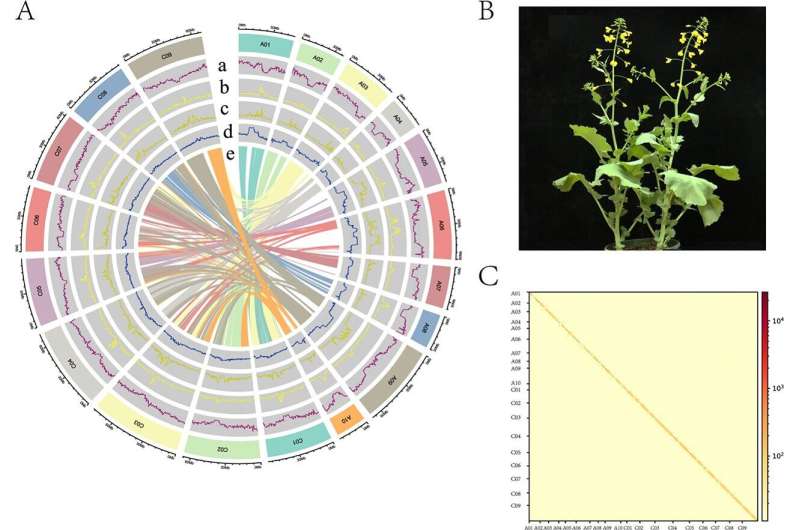This article has been reviewed according to Science X's editorial process and policies. Editors have highlighted the following attributes while ensuring the content's credibility:
fact-checked
proofread
Unveiling a gap-free genome in rapeseed for enhanced agricultural insight and breeding

Allopolyploid oilseed rape (Brassica napus) plays a critical role in global agriculture, serving not only as a major oil crop but also as a nutritious vegetable and ornamental plant. Despite its importance, the current reference genomes, including the latest ZS11_HZAU version, are hindered by unresolved sequences, collapsed duplications, and gaps, limiting comprehensive genomic analysis.
Recent advancements in sequencing technologies, notably the integration of PacBio HiFi and Oxford Nanopore Technologies (ONT) ultra-long reads, have made significant strides in producing gap-free assemblies, exemplified by the complete human genome T2T-CHM13 and several plant genomes. These developments offer new avenues for accurate structural variation (SV) discovery and the identification of presence/absence variations (PAVs), which are crucial for understanding phenotype expression and evolutionary genetics in crops. However, the absence of a gap-free genome for rapeseed has been a major obstacle in accurately identifying SVs related to key traits like flowering time.
In August 2023, Horticulture Research published a study titled "A gap-free reference genome reveals structural variations associated with flowering time in rapeseed (Brassica napus)." This study presents the first gap-free assembly of rapeseed cv. Xiang5A, marking a significant step towards resolving this challenge and facilitating future genomic research and the exploration of previously overlooked functional genes and genomic variants.
To be specific, the genome assembly of Xiang5A (X5A), a paternal line of several elite hybrid rapeseed varieties, was achieved through the integration of HiFi, ONT, and Hi-C data. This strategy resulted in a gap-free genome assembly of 1004.95 Mb, surpassing the estimated genome size of 1033.31 Mb and marked improvements in contiguity, completeness, and accuracy over previous reference genomes. All 19 chromosomes were assembled as contiguous sequences, with eight achieving telomere-to-telomere (T2T) completeness.
The assembly utilized the high accuracy of PacBio HiFi reads as a backbone, integrated with ONT reads for long-range contiguity, achieving an N50 length of 50.70 Mb. This method allowed the filling of all previously unresolved gaps and anchored 1,006,846,396 bp of sequence to 19 pseudochromosomes.
The genome's annotation revealed 580.09 Mb of repeating sequences and identified 124,774 gene models, significantly surpassing the gene count of previous assemblies and capturing 99.2% of a BUSCO reference gene set. Centromere analysis yielded highly contiguous and complete regions, a notable improvement that adds to an understanding of chromosome stability and segregation.
Comparative genomics with 15 species illuminated X5A's evolutionary history, demonstrating its origin through allotetraploidization of B. rapa and B. oleracea. Structural variation analysis highlighted genes influencing flowering time, crucial for rapeseed's adaptability and maturity, offering insights into ecological type diversification and potential breeding targets for early-maturing varieties.
Overall, this study presents a leap in rapeseed genomic research, leveraging advanced sequencing and assembly techniques to produce a highly accurate and complete genome. The gap-free X5A genome serves as a robust foundation for future genetic and agronomic trait research, potentially revolutionizing rapeseed breeding and understanding of its complex genome architecture.
More information: Bao Li et al, A gap-free reference genome reveals structural variations associated with flowering time in rapeseed (Brassica napus), Horticulture Research (2023). DOI: 10.1093/hr/uhad171
Provided by BioDesign Research





















